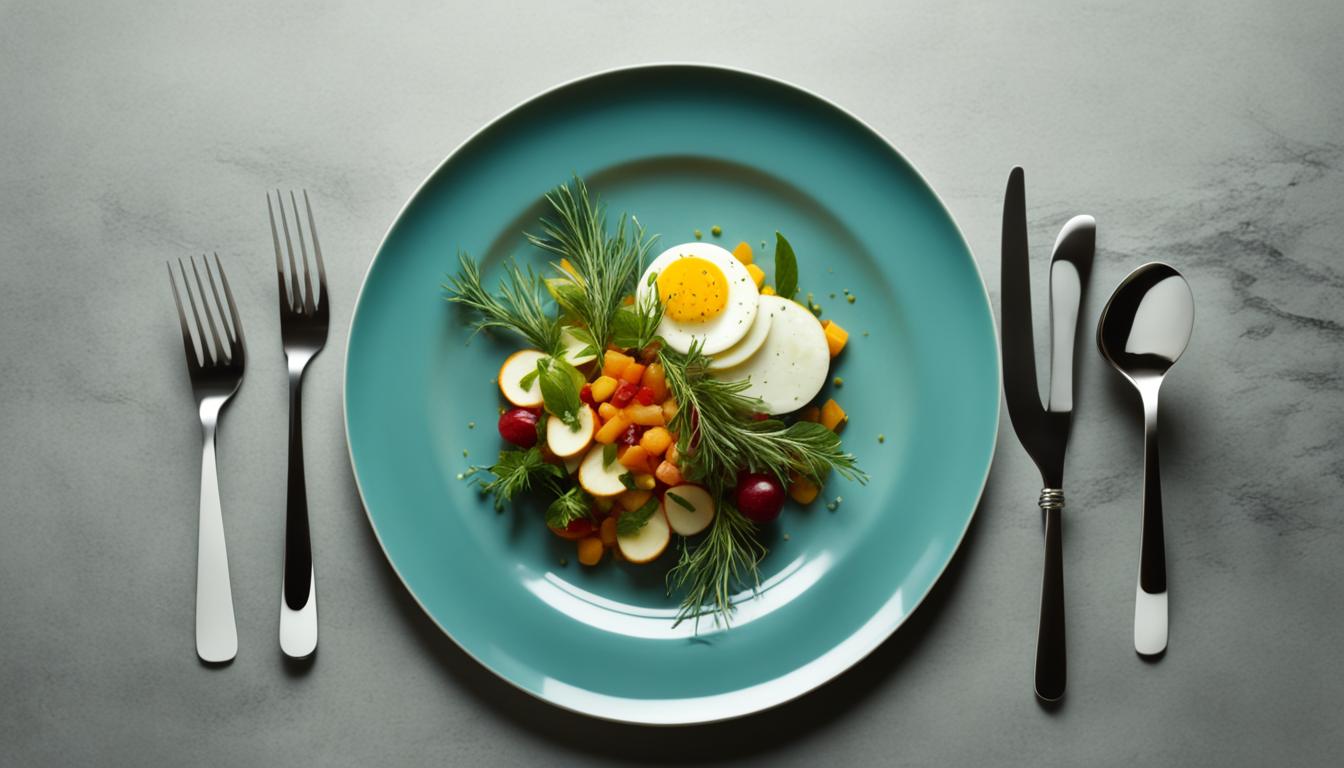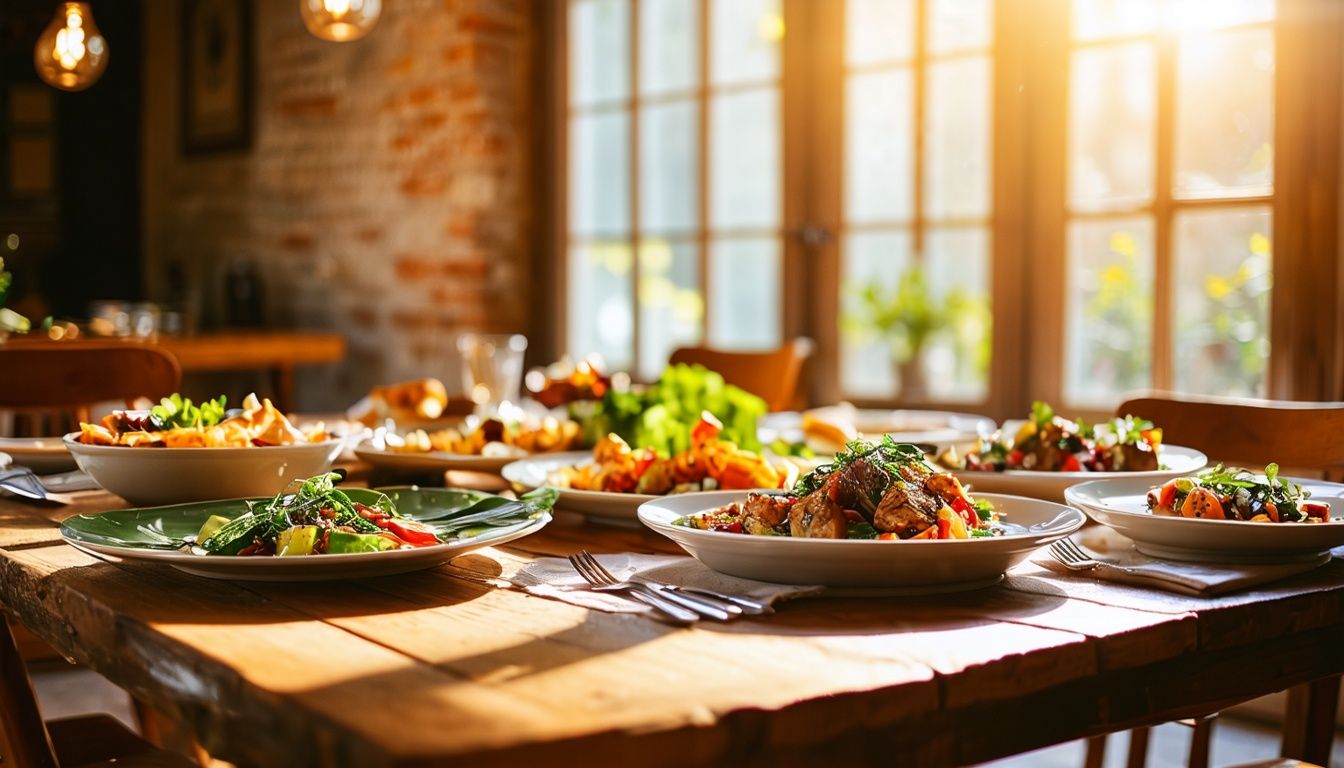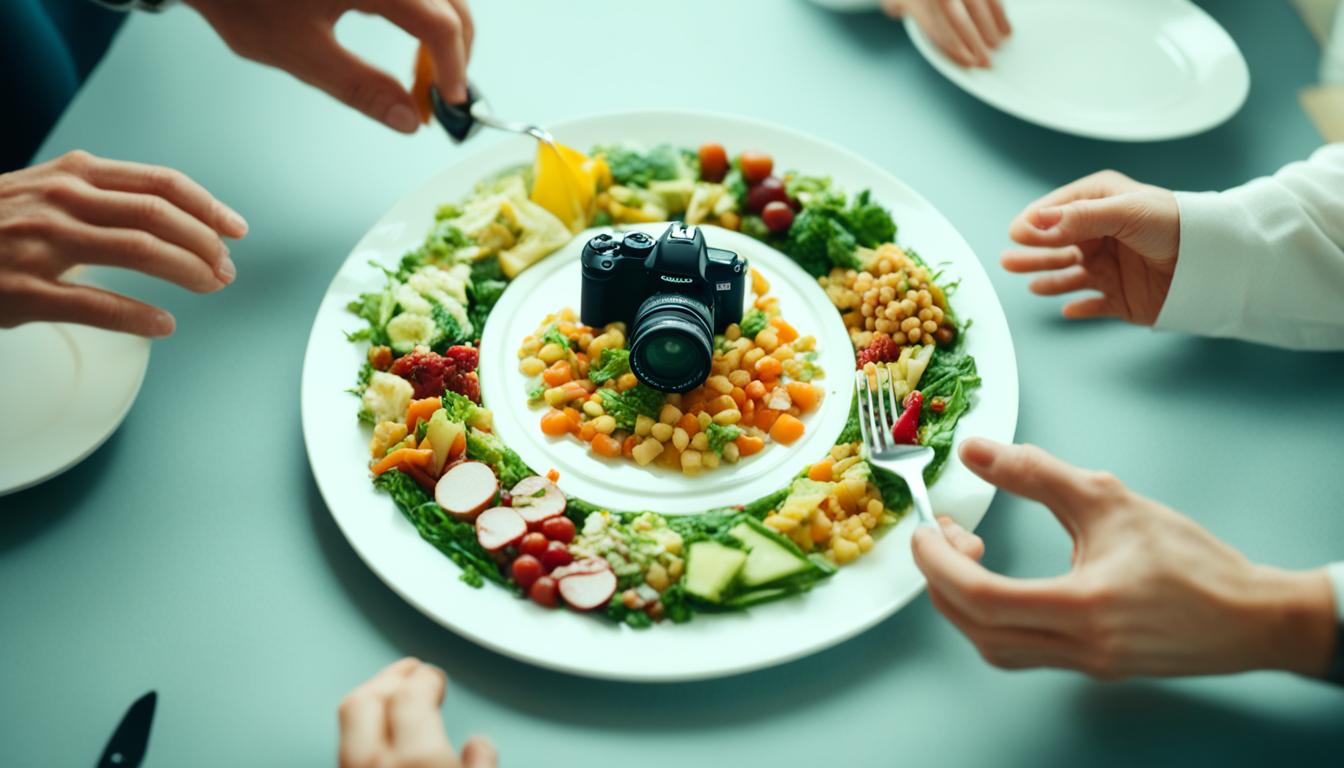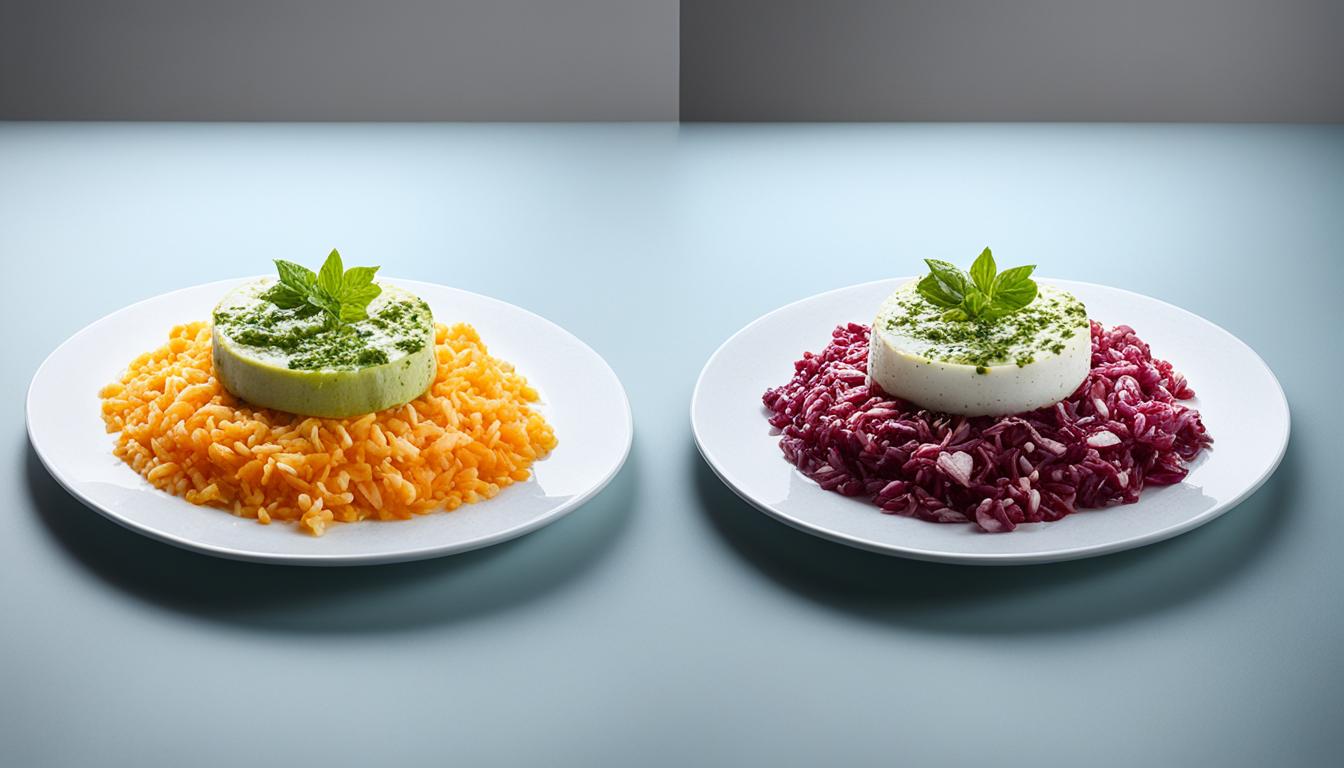Composition and styling are essential elements in food photography that can elevate an ordinary shot into a stunning food story. In this comprehensive guide, we will explore different techniques, tips, and principles for achieving perfect composition and styling in your food photos. From setting up the camera to understanding camera angles, we will cover everything you need to know to capture mouth-watering and visually appealing food images. So, grab your camera and let’s get started!
Key Takeaways:
- Learn composition techniques to create visually appealing food photos.
- Understand the importance of styling in enhancing the overall composition of your images.
- Master camera setup and angles for optimal compositions.
- Apply different styling principles to create depth and appeal in your food photos.
- Plan and practice your compositions to achieve consistent and captivating results.
Setting up the Camera for the Perfect Food Photography Composition
Setting up your camera properly is crucial for achieving the perfect composition in food photography. By using the right equipment, such as a camera tripod and an overhead camera setup, you can ensure stability and capture well-composed food photographs.
When it comes to food photography equipment, investing in a reliable camera tripod is essential. A tripod provides stability and minimizes camera shake, allowing you to capture sharp and clear images. It also enables you to adjust the camera height, angle, and framing with precision, giving you full control over your composition.
An overhead camera setup is particularly beneficial for food photography. It allows you to shoot from above, providing a unique and captivating perspective of your subject. This angle is commonly used to showcase the details and textures of the food, making it an excellent choice for capturing enticing images.
To set up your camera for an overhead shot, position your tripod directly above the table or surface where you’ll be arranging your food. Securely attach your camera to the tripod’s head, ensuring it is stable and level. Adjust the height and angle of the tripod to achieve the desired composition.
When setting up your camera, consider the lighting conditions in your shooting area. Natural light or diffused artificial light can create beautiful and flattering lighting for your food photography. Experiment with different lighting setups to achieve the desired mood and ambiance for your composition.
Camera Setup Checklist
- Camera
- Camera tripod
- Overhead camera setup
- Stable surface or table
- Lighting equipment (natural or artificial)
By setting up your camera correctly and using the right equipment, you’ll be well on your way to capturing visually stunning and well-composed food photographs. Now let’s explore the best camera angles for food photography composition in the next section.
The Best Camera Angle for Food Photography Composition
The camera angle is a crucial element in food photography composition. It has the power to enhance the visual impact of your food photos and create a captivating composition. When it comes to camera angles in food photography, two popular choices are the 45-degree angle and the 90-degree angle.
The 45-degree angle provides a descriptive and natural look at the food. It allows you to capture the details and textures of the dish, creating an enticing visual experience for the viewer. This angle is commonly used in food photography as it showcases the food in a way that feels authentic and inviting.
On the other hand, the 90-degree angle offers a more graphic and eye-catching composition. Shooting from directly above the food can create a sense of symmetry and order. It is an excellent choice for showcasing the arrangement of ingredients or patterns within the dish. This angle works particularly well for flat-lay shots and can help create a visually striking image.
When deciding on the best camera angle for your food photography composition, consider the dish’s shape, texture, and presentation. Experimenting with different angles can help you discover unique perspectives that highlight the essence of the food.

Here are some tips to effectively utilize these camera angles:
- For the 45-degree angle, position yourself slightly above the food and tilt the camera to a 45-degree angle. Ensure that you capture the entire dish within the frame.
- For the 90-degree angle, position yourself directly above the food and shoot straight down. Experiment with different compositions, such as arranging the ingredients in a way that creates symmetry or playing with negative space.
- Consider the impact of lighting on your chosen camera angle. Shadows and highlights can add depth and dimension to your composition.
- Take multiple shots from different angles to capture a variety of perspectives. This will give you more options during post-processing.
By understanding the advantages of different camera angles and applying them creatively, you can elevate your food photography compositions and create visually appealing and engaging images.
Techniques for Achieving Compelling Food Photography Compositions
To create visually appealing and captivating food photography compositions, it is crucial to master various compositional techniques. By understanding and implementing these techniques, you can elevate your food photos to the next level, capturing the attention of your audience and leaving them craving for more.
Arranging Elements to Maintain Interest
One important compositional technique in food photography is the art of arranging elements. Strategically placing different ingredients, culinary tools, and props within your frame can create visual interest and guide the viewer’s eye through the composition. Consider the shapes, colors, and textures of the elements when arranging them to create a harmonious and visually pleasing arrangement.
Using Angles and Orientation
The angle and orientation of your photograph can significantly impact the composition. Experiment with different camera angles, such as shooting from above (overhead) or at a 45-degree angle, to find the most flattering perspective for your dish. Each angle creates a unique visual narrative and can enhance the overall appeal of the food. Additionally, consider the orientation of your composition, whether it’s horizontal or vertical, to further enhance the storytelling aspect of your image.
Incorporating a Focal Subject
A focal subject acts as the main point of interest in your composition, drawing the viewer’s eye and creating a sense of focus. Choose a visually appealing element of your dish, such as a beautifully plated main ingredient or a perfectly styled garnish, to serve as the focal subject. Place it strategically within the frame to strengthen the composition and highlight the dish’s key features.
Utilizing Negative Space
Negative space refers to the empty areas within your composition, providing visual breathing room and emphasizing the subject. Utilize negative space by intentionally leaving empty areas around your dish, allowing it to stand out and shine. This technique can create a sense of minimalism and elegance in your food photography, giving your images a contemporary and refined look.
Applying the Rule of Odds and the Rule of Thirds
The rule of odds and the rule of thirds are two fundamental compositional rules that can enhance the balance and visual impact of your food photos. The rule of odds suggests that an odd number of elements within your composition, such as three or five, creates a more harmonious and visually pleasing image. On the other hand, the rule of thirds involves dividing your frame into a 3×3 grid and placing the main elements of your composition along these lines or at their intersections. This technique adds balance, creates tension, and directs the viewer’s gaze.
| Compositional Techniques | Benefits |
|---|---|
| Arranging elements | Creates visual interest and harmony |
| Using angles and orientation | Enhances perspective and storytelling |
| Incorporating a focal subject | Draws attention and adds impact |
| Utilizing negative space | Emphasizes the subject and adds elegance |
| Applying the rule of odds and the rule of thirds | Enhances balance and directs the viewer’s gaze |
By mastering these compositional techniques, you can create visually captivating and well-balanced food photography compositions. Experiment with different approaches, trust your instincts, and have fun with the process. Remember that practice makes perfect, so keep refining your skills and honing your artistic vision. Happy shooting!
Styling Principles for Food Photography Composition
When it comes to food photography, styling is a vital component of creating captivating compositions. By following a few key principles, you can elevate your food photos and make them visually appealing. In this section, we will explore the essential styling principles that will help you achieve stunning food photography compositions.
Creating a Descriptive and Natural Look
When styling your food, it’s important to create a descriptive and natural look that entices viewers. To achieve this, focus on enhancing the appetizing qualities of the dish. Consider the colors, textures, and details of the food, and present them in a way that highlights their appeal. By capturing the essence of the dish, you can evoke a sense of cravings and desire in your audience.

Using Props to Add Layers and Depth
Props play a crucial role in food photography composition as they can add layers and depth to your shot. Select props that complement the overall theme and mood of the dish. For example, if you’re photographing a rustic homemade pie, consider using vintage utensils or a wooden cutting board to enhance the visual story. Props can also create visual interest by adding different textures, shapes, and colors to the composition.
Utilizing Depth of Field
Depth of field is a powerful tool that can help you create emphasis and separate the food from the background. By using a shallow depth of field, you can blur the background, allowing the focus to solely be on the dish. This technique adds a sense of dimension and draws attention to the main subject. Experiment with different aperture settings to achieve the desired level of depth of field in your food photos.
By incorporating these styling principles into your food photography compositions, you can elevate the overall visual impact of your images. Let’s move on to the next section, where we will explore specific composition techniques that will further enhance the quality and allure of your food photos.
Using Composition Techniques in Food Photography
Composition techniques are valuable tools in food photography for creating visually pleasing and well-balanced compositions. By understanding and utilizing these techniques, you can add depth, flow, and harmony to your food photos.
One popular composition technique in food photography is the rule of thirds. This technique involves dividing your frame into a grid of nine equal parts by imagining two horizontal lines and two vertical lines. The main elements of your composition should then align with these gridlines or their intersections, creating a more visually appealing and balanced image.
Another widely used composition technique is the golden ratio. It is a mathematical ratio that is often found in nature and art. When applied to food photography, the golden ratio can help you determine the placement of your main subject and other elements in a way that feels natural and visually pleasing to the viewer.
“Composition is the foundation of a great food photograph. It is the arrangement and organization of the visual elements within the frame that can make or break the image.”
Dynamic symmetry is another composition technique that can bring a sense of movement and energy to your food photos. It involves using diagonal lines or shapes to create a more dynamic and visually interesting composition.
The golden triangle is a compositional principle that utilizes an imaginary triangle formed by connecting three key elements or focal points within the frame. This technique can create a sense of balance, harmony, and visual flow in your food photos.
Lastly, the golden spiral is a compositional technique that follows the shape of a logarithmic spiral. It can be used to guide the viewer’s eye through the frame and create a dynamic and visually captivating composition.
By experimenting with these composition techniques, you can elevate your food photography and create stunning images that engage and captivate your audience.
Planning and Practicing Food Photography Compositions
Planning and practicing your food photography compositions is crucial for achieving consistent and visually appealing results. It allows you to create a unique food photography style and improve the overall composition of your images. In this section, we will discuss the importance of planning and provide valuable tips for sketching out compositions before shooting. We will also introduce the use of overlays and crop guides, which are valuable tools to help visualize and refine your compositions.
When it comes to planning compositions, taking the time to sketch out your ideas can greatly enhance the outcome of your food photos. By sketching, you can experiment with different arrangements of the food and props, explore various camera angles and compositions, and determine the best placement of elements within the frame. This helps you visualize the final result and make necessary adjustments before actually setting up the shot.
Overlays and crop guides serve as visual aids during the planning process. Overlays are transparent templates that can be placed over your food photos to assess the composition and alignment of elements. They often include grids, lines, and shapes that help you adhere to compositional guidelines, such as the rule of thirds or the golden ratio. Crop guides, on the other hand, can be used to mark the desired cropping area in-camera or during post-processing. They help you frame the subject precisely and eliminate any unnecessary distractions from your composition.
By incorporating these planning techniques into your workflow, you can develop your own food photography style and capture captivating compositions that are visually appealing and engaging. Take the time to sketch, experiment with overlays, and utilize crop guides to refine your compositions and achieve consistent results.
Conclusion
Composition and styling are crucial elements in food photography that can greatly enhance the visual impact of your images. By utilizing various composition techniques, understanding camera angles, and applying styling principles, you can create visually appealing and well-composed food photos that captivate your audience.
To achieve visually appealing compositions, remember to plan your shots carefully. Consider sketching out your compositions before shooting to visualize the arrangement of the elements. Experiment with different overlays and crop guides to refine your skills and create harmonious compositions.
Additionally, don’t underestimate the power of practice. Take the time to familiarize yourself with different composition techniques and apply them in your food photography. Through practice, you’ll develop an eye for detail and a unique style that reflects your creativity and personality.
So, armed with these valuable tips and techniques, go ahead and capture enticing and enchanting food images that delight and inspire your audience. Happy shooting!
FAQ
What is the importance of composition and styling in food photography?
Composition and styling are essential elements in food photography that can elevate an ordinary shot into a stunning food story. They help create visually appealing and well-balanced images that captivate and entice the audience.
What equipment do I need to set up my camera properly for food photography?
To set up your camera properly for food photography, you will need essential equipment such as a tripod, especially for an overhead camera setup. A tripod provides stability and allows you to style your shot more effectively.
What are the best camera angles for food photography composition?
The two popular camera angles for food photography composition are the 45-degree angle and the 90-degree angle. The 45-degree angle provides a natural and descriptive look at the food, while the 90-degree angle creates a more graphic and eye-catching composition.
What are some techniques for achieving compelling food photography compositions?
Techniques for achieving compelling food photography compositions include arranging elements to maintain the viewer’s interest, using angles and orientation to complement the food, incorporating a focal subject, utilizing negative space, and applying the rule of odds and the rule of thirds.
What are the styling principles for food photography composition?
The styling principles for food photography composition include creating a descriptive and natural look at the food, using props to add layers and depth to the composition, and utilizing depth of field to separate the food from the background.
What are some composition techniques to use in food photography?
Some composition techniques to use in food photography include the rule of thirds, the golden ratio, dynamic symmetry, the golden triangle, and the golden spiral. These techniques add depth, flow, and harmony to your food photos.
How can I plan and practice my food photography compositions?
Planning and practicing your food photography compositions is essential for achieving consistent and visually appealing results. Tips for planning include sketching out compositions before shooting and using overlays and crop guides to visualize and refine your compositions.
What is the significance of composition and styling in food photography?
Composition and styling are crucial elements in food photography that enhance the visual impact of your images. By utilizing various techniques and principles, you can create visually appealing and well-composed food photos that captivate and delight your audience.
How Can Composition and Styling Enhance My Food Photography Portfolio?
Composition and styling play a crucial role in food photography portfolio crafting. They help in creating visually appealing and engaging images that showcase the food in the best possible way. By paying attention to the arrangement and presentation of the dishes, you can elevate the overall quality of your portfolio.




